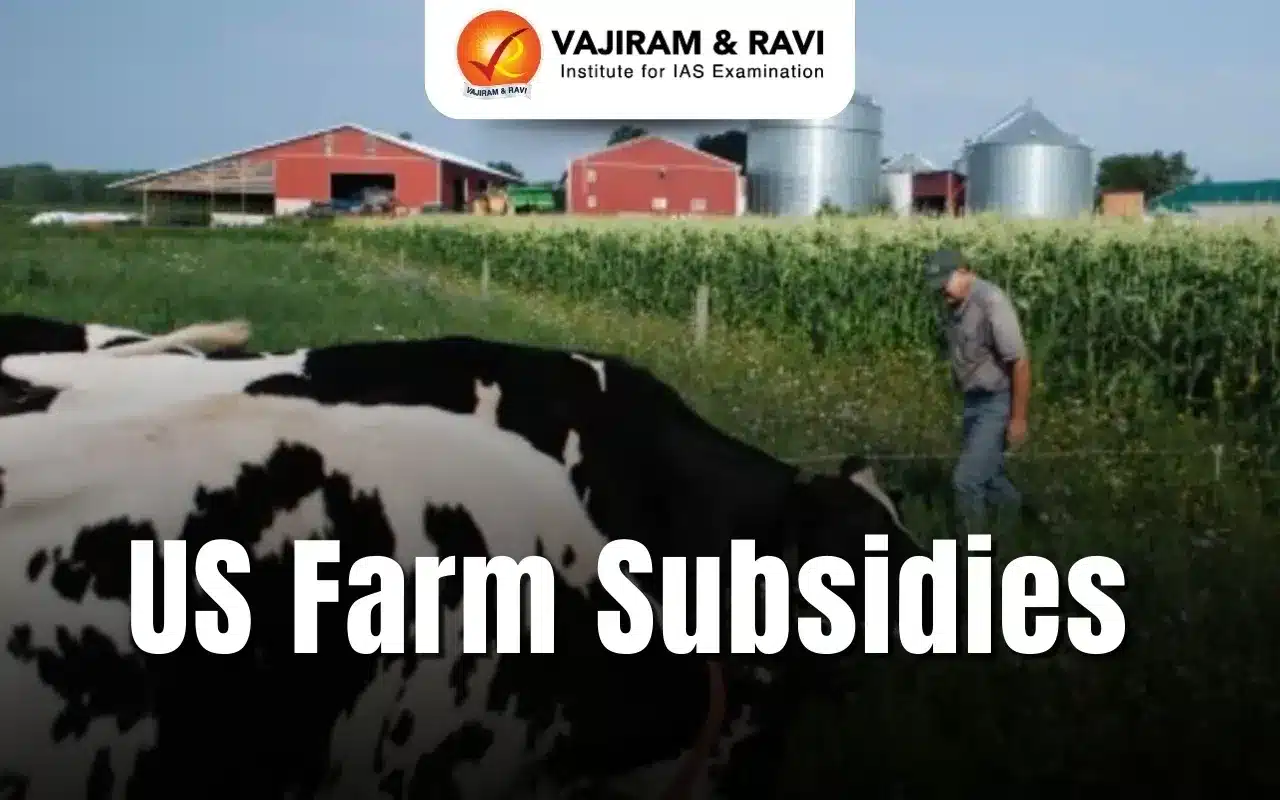What’s in Today’s Article?
- US Farm Subsidies Latest News
- Form of Assistance in the US
- Magnitude of Assistance
- Lessons for India
- Comparison with US Assistance
- US Farm Subsidies FAQs
US Farm Subsidies Latest News
- In 2023, the US had only 1.82 million family farms, far fewer than India’s 93.09 million agricultural households (2019 data). Despite their smaller numbers, US farmers, with a median household income of $97,984 (higher than the national median), receive substantial government support.
- This is a key issue in US-India trade negotiations, as Washington pushes for greater market access for American agricultural products, arguing that India’s farm sector must open up.
Form of Assistance in the US
- Unlike India, the US does not subsidize farm inputs like fertilizer, electricity, or water, nor does it intervene through large-scale procurement and stocking.
- Instead, government support is primarily provided through direct payments to farmers.
Key Financial Assistance Programs
- Price Loss Coverage (PLC)
- Farmers receive payments when the market price of a covered crop falls below the Effective Reference Price (ERP), similar to India’s Minimum Support Price (MSP).
- Unlike India’s MSP, which requires government procurement, US farmers are compensated directly for the price difference.
- Agriculture Risk Coverage (ARC)
- This provides financial assistance when actual revenue from a crop falls below a guaranteed level based on county-specific yields and a five-year price average.
- Dairy Margin Coverage (DMC)
- This program offers financial aid when the margin between farmgate milk prices and feed costs drops below a set threshold, ensuring stable farmer incomes.
- These mechanisms help US farmers manage price fluctuations and revenue shortfalls, providing a more predictable income without direct market interventions.
Magnitude of Assistance
- The US farm sector receives substantial direct payments from the government, ranging from $9.3 billion to $45.6 billion in recent years.
- These payments help farmers manage risks and income fluctuations.
Key Financial Assistance Figures
- Peak Assistance in 2020 – Farmers received $45.6 billion, including $31.4 billion in pandemic and disaster relief, making up 38% of their net cash income.
- Projected Payments for 2025 – Estimated at $42.4 billion, largely driven by disaster assistance under the American Relief Act of 2025.
- Total Aid (2019-2023) – The US Government Accountability Officereported that $161 billion was disbursed through 27 programs, with major allocations:
- Crop insurance: $53.6 billion
- COVID-19 aid: $30.9 billion
- Trade relief: $22.6 billion
- PLC/ARC/DMC payments: $16.8 billion
- Environmental conservation: $16.2 billion
Lessons for India
- India provides substantial support to its farmers through multiple subsidy programs, but the distribution and impact differ significantly from the US model.
Scale of Agricultural Support
- Total Annual Assistance – Estimated at ₹5 lakh crore ($57.5 billion), covering:
- PM-Kisan: ₹63,500 crore (₹6,000 per farmer annually)
- Fertilizer subsidy: ₹1,71,300 crore
- Crop loan subsidy: ₹22,600 crore
- Crop insurance subsidy: ₹15,864 crore
- MSP procurement and state-level subsidies
Comparison with US Assistance
- India’s support is spread across 111 million farmers, while the US aids just 1.04 million.
- Average annual federal payment:
- India (PM-Kisan): ₹6,000 ($69) per farmer
- US: ₹26.8 lakh ($30,782) per producer
Unequal Competition in Trade Negotiations
- US farmers, despite fewer in number, receive far greater direct financial assistance.
- Opening India’s agricultural market to US produce could lead to unfair competition due to the disparity in government support.
- World Trade Organization (WTO) rules allow “special and differential treatment” for developing nations, ensuring they are not forced into reciprocal trade concessions.
Key Question for US-India Trade Talks
- Whether the US will respect this WTO principle of non-reciprocity—allowing India to safeguard its farmers without equivalent market access for American produce—remains uncertain.
US Farm Subsidies FAQs
Q1. What are US farm subsidies?
Ans. US farm subsidies are direct payments to farmers for price support, risk coverage, and disaster relief.
Q2. How do US subsidies differ from India’s?
Ans. The US provides direct cash payments, while India subsidizes inputs like fertilizers, water, and electricity.
Q3. Why do US farm subsidies impact India’s trade?
Ans. They create an uneven playing field, as US farmers receive more direct financial support than Indian farmers.
Q4. What is the WTO’s stance on farm subsidies?
Ans. WTO allows special treatment for developing nations, preventing forced reciprocal market access.
Q5. What role do farm subsidies play in US-India trade talks?
Ans. The US demands market access, while India argues for protection due to subsidy disparities.
Last updated on December, 2025
→ Check out the latest UPSC Syllabus 2026 here.
→ Join Vajiram & Ravi’s Interview Guidance Programme for expert help to crack your final UPSC stage.
→ UPSC Mains Result 2025 is now out.
→ UPSC Notification 2026 is scheduled to be released on January 14, 2026.
→ UPSC Calendar 2026 is released on 15th May, 2025.
→ The UPSC Vacancy 2025 were released 1129, out of which 979 were for UPSC CSE and remaining 150 are for UPSC IFoS.
→ UPSC Prelims 2026 will be conducted on 24th May, 2026 & UPSC Mains 2026 will be conducted on 21st August 2026.
→ The UPSC Selection Process is of 3 stages-Prelims, Mains and Interview.
→ UPSC Result 2024 is released with latest UPSC Marksheet 2024. Check Now!
→ UPSC Prelims Result 2025 is out now for the CSE held on 25 May 2025.
→ UPSC Toppers List 2024 is released now. Shakti Dubey is UPSC AIR 1 2024 Topper.
→ UPSC Prelims Question Paper 2025 and Unofficial Prelims Answer Key 2025 are available now.
→ UPSC Mains Question Paper 2025 is out for Essay, GS 1, 2, 3 & GS 4.
→ UPSC Mains Indian Language Question Paper 2025 is now out.
→ UPSC Mains Optional Question Paper 2025 is now out.
→ Also check Best IAS Coaching in Delhi

















